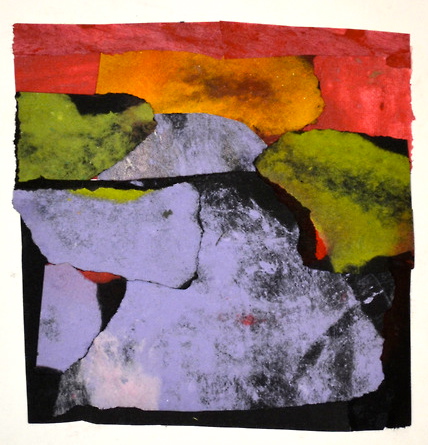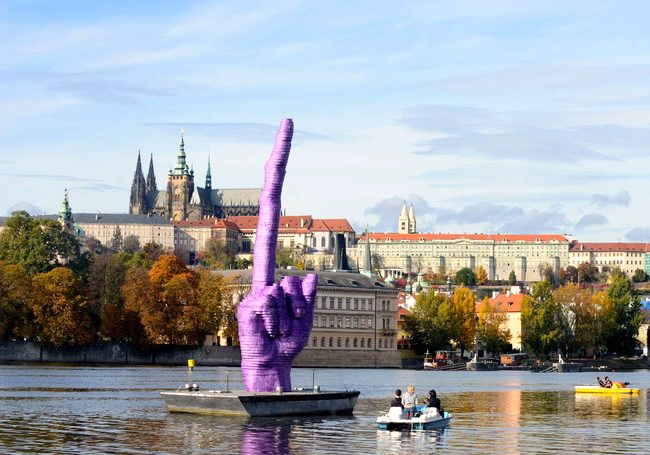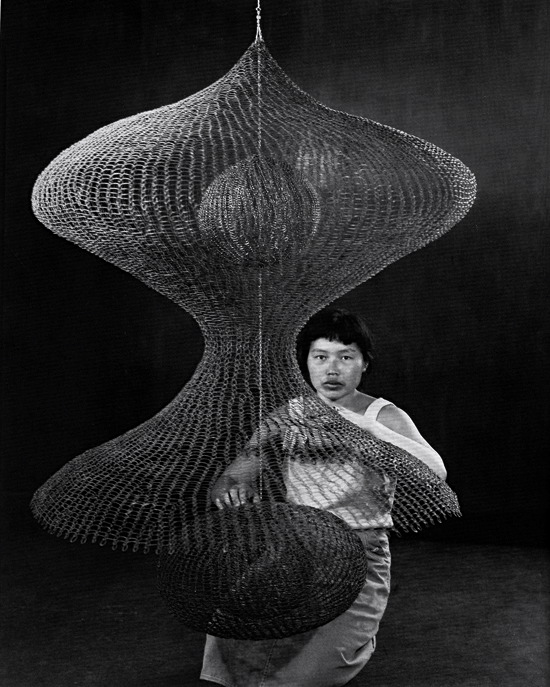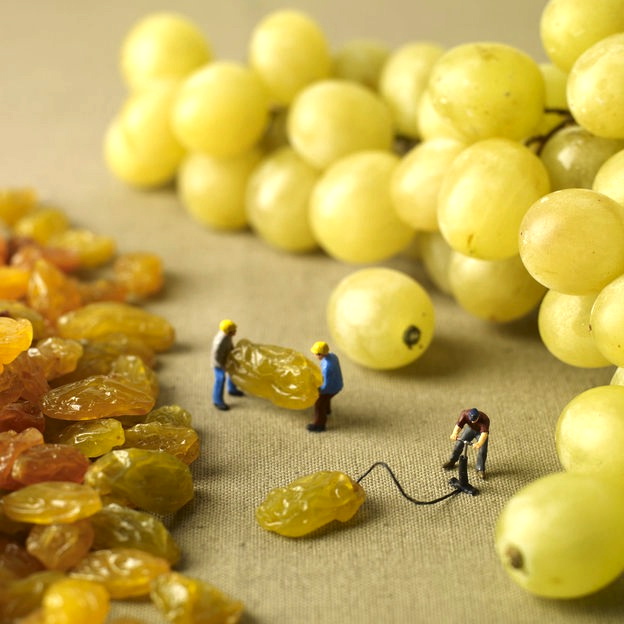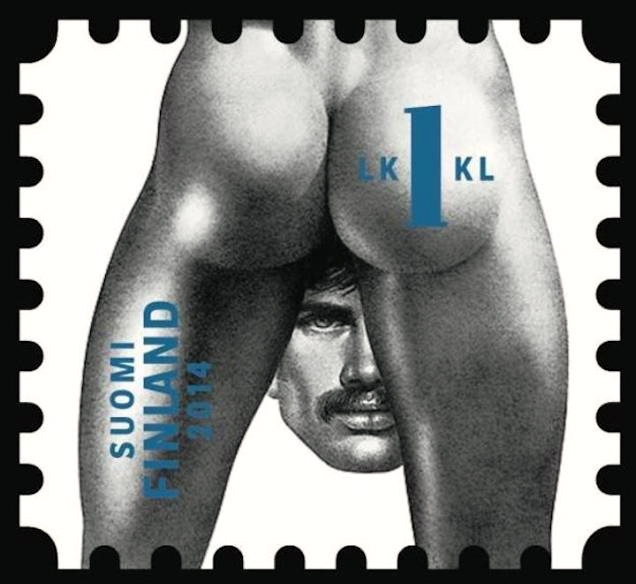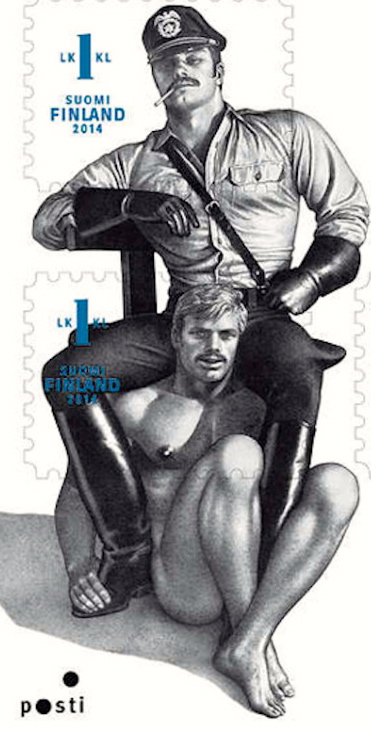From several sources, pointers to this piece of in-your-face public art:
![]() (#1)
(#1)
The story from the NYT on the 22nd: “Angry at Prague, Artist Ensures He’s Understood”, by Dan Bilefsky:
“The finger,” said the Czech sculptor David Cerny [in Czech spelling Černý] “speaks for itself.” On that point, at least, everyone could agree.
Mr. Cerny is not known for understatement or diplomacy, from depicting Germany as a network of motorways resembling a swastika to displaying a caricature of a former Czech president inside an enormous fiberglass rear end.
But on Monday, Mr. Cerny, 45, took his political satire to new heights — or depths, depending on your perspective — when, on the eve of Czech general elections this weekend, he installed on the Vltava River a 30-foot-high plastic purple hand with a raised middle finger. It is a symbol, he said, that points directly at the Prague Castle, the seat of the current Czech president, Milos Zeman
Mr. Cerny said the monumental hand with its 16-foot-long outstretched middle finger, placed on a float facing the castle, was a “scream of alarm” against the state of politics in the Czech Republic, endemic corruption and Mr. Zeman, a former leftist prime minister, whom he accused of becoming intoxicated with power.
He said the sculpture, which he gave an unprintable title, was also aimed at the country’s Communist Party, which could gain a share of power in the coming elections for the first time since the revolution that overthrew communism more than two decades ago.
The statue is generally referred to as “Middle Finger”, though presumably the Czech name is something stronger, like ‘Up Yours” or ‘Fuck You’.
On the finger, from Wikipedia:
In Western culture, the finger (as in giving someone the finger or the bird), also known as the finger wave, the middle finger, flipping someone off, flipping the bird, shooting the bird, the rude finger or the one finger salute, is an obscene hand gesture, which is often a sign of extreme or moderate contempt, roughly equivalent in meaning to “fuck off”, “fuck you”, “shove it up your ass”, or “go fuck yourself.” It is performed by showing the back of a closed fist that has only the middle finger extended upwards, though in some locales the thumb is also extended. Extending the finger is considered a universal symbol of contempt in several cultures, especially Western cultures. Many cultures do use similar gestures to display their disrespect, though others use it to express pointing with no intentional disrespect toward other cultures.
There’s a rich literature on the finger. One of its byways is the appearance of the Flying Fickle Finger of Fate on the Laugh-In tv show:
Rowan & Martin’s Laugh-In (often simply referred to as Laugh-In) is an American sketch comedy television program that ran for 140 episodes from January 22, 1968, to March 12, 1973, on the NBC television network. It was hosted by comedians Dan Rowan and Dick Martin and featured, at various times, Chelsea Brown, Johnny Brown, Ruth Buzzi, Judy Carne, Richard Dawson, Henry Gibson, Teresa Graves, Goldie Hawn, Arte Johnson, Larry Hovis, Jeremy Lloyd, Dave Madden, Pigmeat Markham, Gary Owens, Pamela Rodgers, Barbara Sharma, Alan Sues, Lily Tomlin and Jo Anne Worley.
… The Flying Fickle Finger of Fate Award, saluting actual dubious achievements by the government or famous people, such as the announcement of a new Veterans Administration hospital to be erected in Southern California shortly after another such facility was destroyed in the Sylmar earthquake of 1971. The trophy was a gilt, outstretched finger atop a square base. “The flying, fickle finger of fate” was already a familiar catchphrase on the show (Dan Rowan would use the phrase when ushering “new talent” like Tiny Tim on stage).
As I noted in a posting on Zippy the Pinhead, cartoonist Bill Griffith has an attraction to
tabooed F words, especially the Big F, fuck. The American tv comedy show Laugh-In flirted with the F Word on a regular basis, notably in Rowan and Martin’s granting of Flying Fickle Finger of Fate awards, “saluting actual dubious achievements by the government or famous people” (from the Wikipedia page), and in appearances by the Farkel Family, a large clan who were introduced, one by one, by name, on every appearance: Sparkle Farkel, Flicker Farkle, the twins Simon and Gar Farkel, Charcoal Farkel (a black child, identical twin to the white Sparkle Farkel), Mark Farkel, Fritz and Fred Farkel. The sketches presented occasions for cast-challenging tongue twisters like “That’s a fine-looking Farkel flinger you found there, Frank”.
Two other Černý sculptures:
![]() (#2)
(#2)
![]() (#3)
(#3)
An often playful, and rarely subtle, artist.
[Addendum: an earlier posting on the finger, "Annals of obscene gestures" of 2/5/13.]
![]()
![]()







